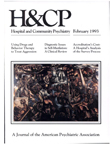An In-Home Crisis Intervention Program for Children and Their Families
Abstract
During 1 989, the second year of operation and the first full year of services, the home-based crisis intervention program improved service delivery, increased the number of families served, and strengthened referral procedures. However, the program was limited by continued staff turnover and did not meet its goals related to the number of families served.
The program provides a viable alternative to psychiatric hospitalization at a low cost and is associated with savings related to prevention of hospitalization. The cost of psychiatric hospitalization at Erie County Medical Center was $400 a day in 1989. The average length of hospitalization at the center was 11 days. We estimate that the crisis intervention program prevented 31 such hospitalizations, providing an estimated savings of $136,400. Several of the patients who would have been hospitalized at Erie County Medical Center would also have been likely to be admitted to Western New York Children's Psychiatric Center for longer-term care. If only 25 percent of the children served by the crisis intervention program had been hospitalized at the children's psychiatric center, where the average length of stay is 60 days at $400 a day, the cost would have been $186,000. Thus the program was associated with an estimated total savings of $322,400 in hospital costs.
Further research should include a comparative follow-up of families who refused crisis intervention services and follow-up of clients who participated in the program to determine if they used other outpatient psychiatric services in addition to the crisis intervention program.
Langsley and Kaplan (1) have pointed out that family crisis therapy may entail certain burdens for the family, but it also has many advantages, especially increased awareness of crises, new techniques for handling them, clarification and perhaps resolution of the dissatisfactions of other family members, greater family cohesiveness, and a heightened sense of the family's competence to manage its own problems. Programs such as the home-based crisis intervention program of Buffalo General Hospital can help prevent hospitalization of children and adolescents and provide high quality, cost-effective mental health services.
Access content
To read the fulltext, please use one of the options below to sign in or purchase access.- Personal login
- Institutional Login
- Sign in via OpenAthens
- Register for access
-
Please login/register if you wish to pair your device and check access availability.
Not a subscriber?
PsychiatryOnline subscription options offer access to the DSM-5 library, books, journals, CME, and patient resources. This all-in-one virtual library provides psychiatrists and mental health professionals with key resources for diagnosis, treatment, research, and professional development.
Need more help? PsychiatryOnline Customer Service may be reached by emailing [email protected] or by calling 800-368-5777 (in the U.S.) or 703-907-7322 (outside the U.S.).



